Composition and calorie content of Chinese pears depending on the variety, why they are useful
The ancestors of the Chinese pear (Taiwanese, Japanese, shortbread) are neshi (yamanesh) trees. Once upon a time, Chinese agronomists crossed a pear and an apple to produce a juicy, not sour and not cloyingly sweet fruit. From the article you will learn about the characteristics of the crop, the benefits and harms, how many calories are in the fruits and how to store them correctly.
Characteristics of Chinese pear
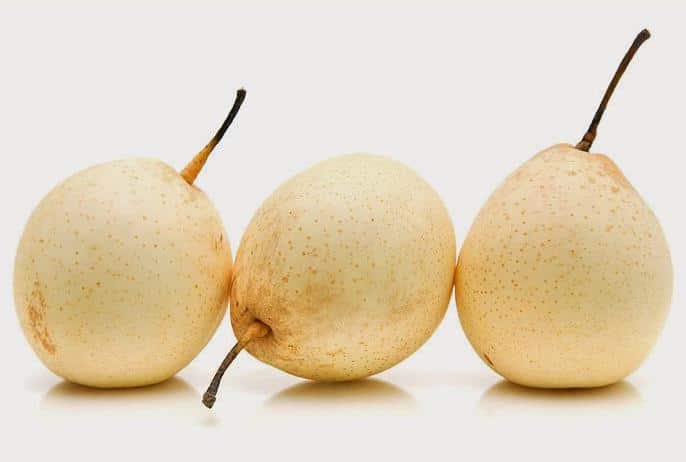
There are a large number of varieties of Chinese pear known. They differ in the taste of the fruit, size and ripening time. 100 g of nasha contains only 45 kcal. The calorie content of a Chinese pear depends on the size and heat treatment. Energy value juice is low, also 45 kcal per 100 g of drink. The calorie content of dried fruit is higher - 250 kcal per 100 g, fruit jam - 273 kcal per 100 g due to the addition of sugar.
BZHU pears:
- proteins – 0.5 g;
- fats – 0.24 g;
- carbohydrates – 7.06 g.
The ratio of BJU product is 5%:5%:67% of the daily requirement.
Reference. The glycemic index of nasha is 30 units (for diabetics the norm is up to 50 units). Nutritionists advise everyone who is on a diet to eat Chinese pear and allow those with diabetes to eat it.
The most popular varieties of Chinese pear in our country
Brief description of some crop varieties:
- Apple-pear Kosui. The fruits are medium-sized, weighing up to 160 g, rich bronze color, with juicy pulp. 100 g of Kosu contains 45 kcal.
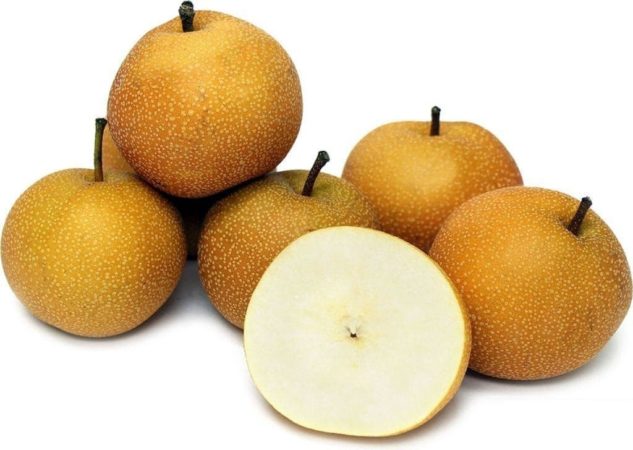 Kosu
Kosu - Hosui. They have sweet pulp and contain 12% sugar. The fruits weigh on average 200 g, but can reach 300 g. The color is bronze-brown, the flesh is dense. The calorie content of the variety is about 47 kcal per 100 g.
- Olympic. A variety with a pleasant fruity aroma. The weight of one fruit reaches 200 g, the taste is original, the pulp is juicy. The calorie content of the variety is about 44 kcal per 100 g.
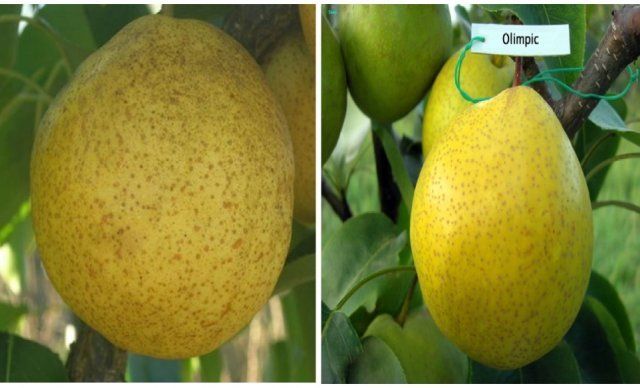 Olympic
Olympic - Crystal. The fruits are light yellow in color and weigh 160-220 g. These pears have the lowest calorie content - 42 kcal per 100 g. Their juicy pulp has a delicate taste.
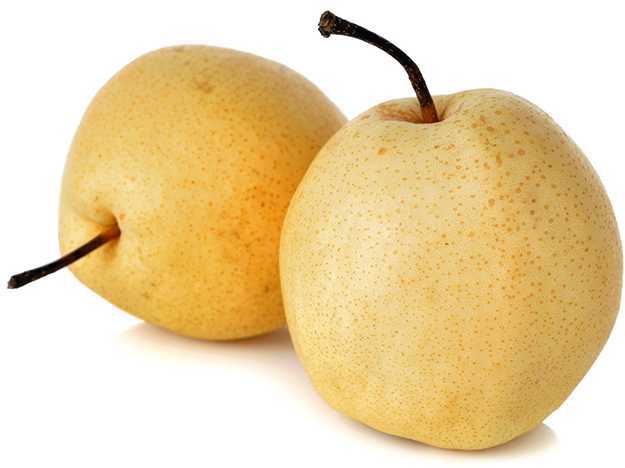 Khrustalnaya
Khrustalnaya
The benefits of Chinese pear
Nashes contain a record amount of valuable minerals, vitamins and microelements:
- Vitamin C has an antioxidant effect and improves immunity.
- Vitamin K has a positive effect on blood clotting.
- The B complex of vitamins stabilizes nerve impulse conductivity and regulates brain function.
- Vitamin B9, or folic acid, – stimulant of serotonin, the “hormone of joy”.
- Vitamin E – “female” vitamin, improves skin regeneration and prevents the formation of wrinkles.
- Pectin normalizes intestinal function.
- Potassium regulates the functioning of the cardiovascular system, normalizes water and electrolyte balance and improves kidney function.
- Calcium strengthens bones.
- Phosphorus (11 mg per 100 g) acts as an energy carrier and stimulates the regenerative abilities of bone tissue.
- Magnesium (8 mg per 100 g) improves the absorption of proteins, accelerates lipid metabolism, and regulates the function of the nervous system.
- Copper activates the production of red blood cells and increases the body's resistance to pathogenic microflora.
The fruit also contains dietary fiber. They improve the functioning of the gastrointestinal tract and help cleanse the body.In addition, the presence of fiber helps reduce blood sugar and cholesterol levels.
Reference. Just one eaten pear fulfills the daily requirement for vitamin C by 8%, and copper by 45%.
Is it possible to eat Chinese pears on a diet?

Due to their low calorie content and the presence of a large amount of useful substances, nashi is an excellent addition to the diet of people who want to lose weight.
2-3 fruits will satisfy your hunger well and will be a wonderful snack. People with a sweet tooth can eat pears without the risk of gaining extra pounds. In addition, these fruits will bring much more benefitsthan chocolates. Those who are watching their figure can be advised to replace sweets with juicy fruits.
Harm and contraindications
Chinese pear is very healthy and practically does not harm the body. Contraindications include individual intolerance and allergic reactions to the fruit.
Also, doctors do not recommend eating fruits at the same time as dairy and meat products. This will cause disruptions in the digestive system and lead to dysbiosis. You should not eat unripe fruits; this also has a bad effect on the gastrointestinal tract.
Reference. To prevent heartburn, it is not recommended to eat a pear on an empty stomach. Before eating, you need to remove the skin from the fruit, as it may have been treated with chemicals.
How to choose and store fruit correctly
The fruits of Chinese pears are exported to our country, so they are collected unripe so that they do not spoil in transit. As a result, the risk of buying fruit that is not yet ripe is very high. Let it ripen for several days. It is best to purchase fruits from trusted and licensed suppliers.
When choosing a nashi, pay attention to the absence of rot, stains, and cracks.Be sure to inquire about the date of fruit harvest.
Reference. It is not recommended to wash fruits after purchasing if you do not intend to eat them immediately. Washed fruits spoil quickly in the refrigerator.
Consumption norms per day
A healthy person can eat several Chinese pear fruits every day. Pregnant women should reduce this amount to two fruits per week.
Nashi is best consumed fresh, in which case all the beneficial substances are preserved. Pears are often used as a filling for pies and jam is made from it, but after heat treatment it will not be as beneficial for the body.
If you want to go on a fruit diet, it is very important to discuss the amount of fruit you eat with your personal nutritionist. Only he can say for sure in what volume and with what this kind of fruit should be consumed.
This is interesting:
Is it possible to ripen pears at home and how to do it
Reviews of Chinese pear
Forum participants share their impressions about the taste and benefits of Chinese pear.
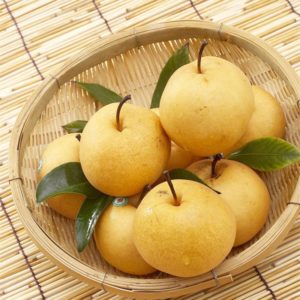
Elena, 29 years old: “I try to lead a healthy lifestyle, so fruits and vegetables are an essential part of my diet. One day I saw a Chinese pear in a store and decided to try it, because I know that it is healthy and low-calorie. The pear turned out to be very tasty and juicy. Now it often appears on my table, and I recommend it to my friends.”
Marina, 37 years old: “I love it for its pleasant taste and juiciness. I often buy it because I have constant problems with the gastrointestinal tract, and Nashi pears contain dietary fiber, which cleanses the intestines of toxins. Another advantage of these fruits is their low calorie content.Girls who dream of losing weight, take note of this fruit!”
Irina, 24 years old: “Pear is not my favorite fruit, so I buy it most often for my parents and sister. But sometimes I can indulge in a piece of fruit. Its taste is pleasant, sweet, the flesh is very juicy, so it is better to cut the pear into pieces. Small brown seeds are present, but they are few in number, and the core itself is also small. The aroma is pear, classic.”
Conclusion
Chinese pear (neshi) is distinguished not only by its excellent taste and external qualities, but also has a number of beneficial properties for the body of a child and an adult. Juice, preserves and jam are prepared from the fruit, added to various desserts, pies, pancakes, salads, sauces, baked in the oven with meat and even smoked.